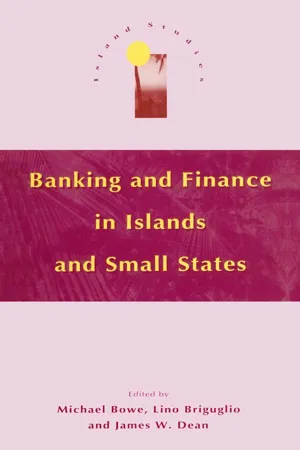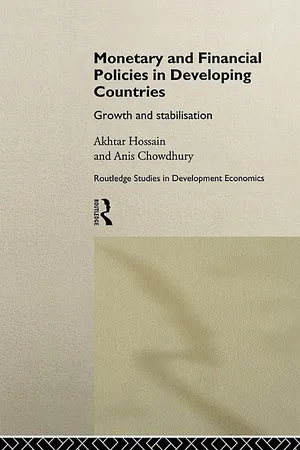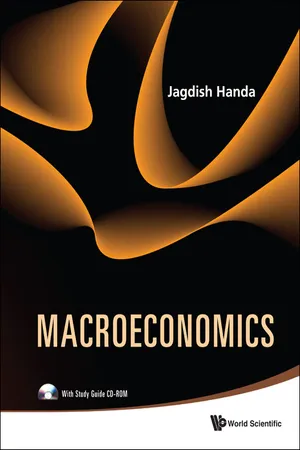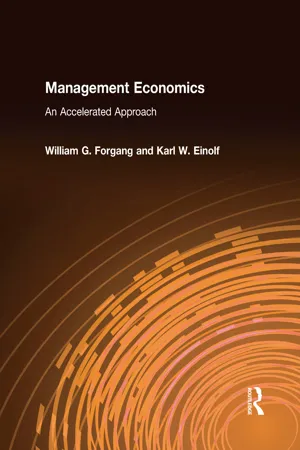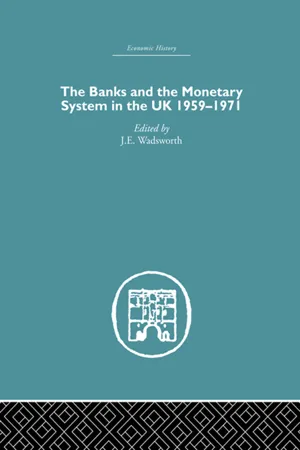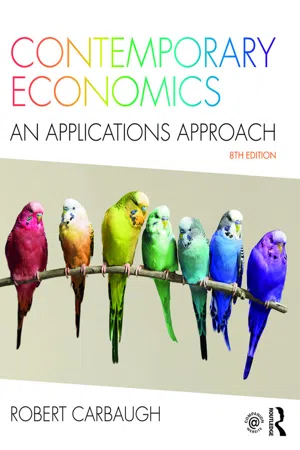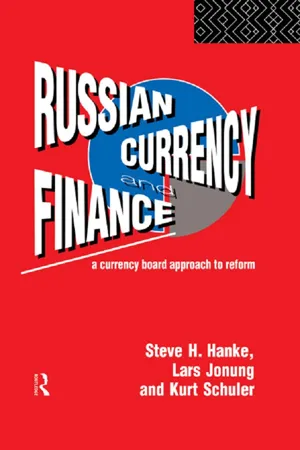Economics
Money Supply Process
The money supply process refers to the various factors and mechanisms that influence the amount of money in circulation within an economy. It involves the actions of central banks, commercial banks, and the public in creating and controlling the supply of money. Changes in the money supply can have significant impacts on inflation, interest rates, and overall economic activity.
Written by Perlego with AI-assistance
Related key terms
10 Key excerpts on "Money Supply Process"
- eBook - ePub
- Michael Bowe, Lino Briguglio, James W. Dean(Authors)
- 2014(Publication Date)
- Routledge(Publisher)
12The Money Supply Process in Two Small Island States: Malta and Cyprus, 1960–1993 *
Joe Falzon
What, then, has determined and will determine the value of the franc? First, the quantity, present and prospective, of the francs in circulation. Second, the amount of purchasing power which it suits the public to hold in that shape The first of these two elements … depends mainly on the loan and budgetary policies of the French Treasury. The second of them depends mainly … on the trust or distrust which the public feel in the prospects of the value of the franc.John Maynard Keynes, A Tract on Monetary Reform (1923)The Money Supply Process is of considerable importance in the economy because of the close relationship between changes in the money supply and changes in real output. Friedman and Schwartz (1963), in their celebrated study of the monetary history of the United States, showed that there exists a positive correlation between the money supply and real output: increases in the total stock of money occurred during expansions, while decreases were witnessed during recessions.Moreover, Sims (1972) showed that the innovations in the money stock preceded the innovations in output. Past changes in real output were unable to predict changes in the money stock. On the other hand, past changes in the money stock could help predict changes in output and in real economic activity. More recently, Stock and Watson (1989), using detrended data concerning the money stock, also present support for the view that movements in the quantity of money help to forecast changes in real output.Becketti and Morris (1992) have investigated the ability of money to predict economic activity after the 1970s. They found that, except during the early 1980s, money has remained a useful indicator of future economic activity. A number of developments in financial markets during the early 1980s changed the relationship between money and future real growth, thereby reducing the ability of money to forecast economic activity. When this period of change is excluded from the analysis, however, the predictive ability of money to forecast real economic activity remains intact. - Anis Chowdhury, Akhtar Hossain(Authors)
- 2003(Publication Date)
- Routledge(Publisher)
Chapter 5 that money supply affects real output only in the short run so long as there are rigidities in the system. On the other hand, there is overwhelming evidence showing that monetary expansion has been an important influence on inflation. Thus there is a broad consensus that the stability of the price level should be the ultimate goal of monetary policy.A MONEY MULTIPLIER MODEL OF THE Money Supply Process
This section specifies a simple model of the Money Supply Process to examine the controllability of monetary aggregates in developing countries.1 The model is based on the fractional reserve system in which commercial banks are required by law to keep a fraction of their deposit liabilities as reserves with the central bank.Monetary aggregates can be defined either narrowly or broadly. The narrow money (M1) comprises currency in circulation (Cp) and demand deposits (Dd)The broadly defined money (M2) iswhere Dt=time or fixed deposits. Assuming that total deposits are divided into demand and time deposits in a fixed ratio (e), thenSubstitution of equation (6.3) in equation (6.2) yieldsWhile the currency held by the non-bank public (Cp) is the central bank’s liability, deposits (Dd and Dt) are the liabilities of commercial banks. Thus M1 and M2 represent the liabilities of the banking system and it is essential to examine the balance sheet of the banking system for an understanding of the process of money creation. The central banks balance sheet is given as- eBook - ePub
- W. Charles Sawyer, Richard L. Sprinkle(Authors)
- 2020(Publication Date)
- Routledge(Publisher)
2 Internationally, this definition of the money supply is known as narrow money.Other definitions of money are possible. There are a number of financial assets that are referred to as near monies that can be used as money in many circumstances. Near monies are highly liquid financial assets such as savings accounts, time deposits, and short-term government securities. In many cases, these assets cannot be spent as easily as can currency or a demand deposit at a local bank. An example of a near money is an account with a money market mutual fund. In the U.S., this is a common form of near money. In other countries, where this form of near money is less common, a large amount of near money is held in the form of time deposits. For the most part, near monies do not function as a medium of exchange but they can be readily converted into currency or demand deposits. For the U.S., M1 plus money market mutual funds and time deposits constitutes M2. In an international context, the term for M2 is called broad money.Ultimately, the supply of money within a country is the result of a process that we need to describe. In order to do this we will need to look at an important part of the money supply known as the monetary base (B). The monetary base (B) is composed of cash in the hands of theBOX 15.1WHAT IS THE SUPPLY OF MONEY?Even though the public can hold money for a variety of reasons, the supply of money that is relevant for the purposes of economic policy is a measure of money that will be used for economic transactions within a given period of time, such as a year. Unfortunately, in most countries such a perfect measure of the money supply does not exist. For example, in the U.S. neither M1 nor M2 is identical to the supply of money the public uses for short-run economic transactions. The primary reason why this is true is related to the existence of money market mutual funds. These funds can be used for transactions, as each account has limited check-writing capabilities. In addition, these accounts are also widely used as a parking place for funds between the purchase and sale of equities, bonds, and other long-term financial assets. As a result, M1 understates the amount of money that the public could use for short-run economic transactions, and M2 overstates this same amount. In this case, the central bank of the U.S. cannot know with certainty what the amount of money is that the public intends to use for short-run economic activities. To a greater or lesser extent, every country has this problem of defining what the relevant supply of money is. In the discussion that follows, we assume that there is a relevant supply of money under the central bank’s control. However, one should keep in mind that the supply of money in an economy is not as clear-cut in most cases as central bankers or those following the state of the economy might like. - eBook - ePub
Macroeconomics
(With Study Guide CD-ROM)
- Jagdish Handa(Author)
- 2010(Publication Date)
- WSPC(Publisher)
near-banks — i.e., those financial institutions in which the deposits perform almost the same role for depositors as similar deposits in commercial banks. Examples of such institutions are savings and loan associations and mutual savings banks in the United States (USA); credit unions, trust companies, and mortgage loan companies in Canada; and building societies in the United Kingdom (UK). The incorporation of such deposits into the measurement of money is designated by the symbols M3, M4, etc., or by M2A (or M2+), M2B (or M2++), etc. However, the definitions of these symbols have not become standardised, so that their definitions remain country specific.Financial institutions in the economyFinancial institutions are firms involved in the process that determines the money supply and interest rates. They also intermediate between the borrowing and lending processes in the economy. In practical terms, financial institutions include the central bank, commercial banks, near-banks such as credit unions, trust companies, brokerage companies, postal banks, pension funds, etc. They do not engage in the production or consumption of commodities but receive funds from some sources and channel them to others (i.e., invests them).2.2 Money Supply and Money StockMoney is a good, which, just like other goods, is demanded and supplied by the various participants in the economy. There are a number of determinants of the demand and supply of money. The most important of the determinants of money demand are national income, the price level, and interest rates, while that of the money supply is the behavior of the central bank of the country which is given the power to control the money supply and bring about changes in it.The equilibrium amount in the market for money specifies the money stock , as opposed to the money supply , which is a behavioral function. These are depicted in Figure 2.1a with the nominal quantity of money M on the horizontal axis and the market interest rate r on the vertical axis. The money supply curve is designated as M s and the money demand curve is designated as M d . The equilibrium quantity of money is . It equals the quantity of money supplied at the equilibrium interest rate . Note that the quantity is strictly speaking not the money supply, which has a curve or a function rather than a single value. However, is the money stock that would be observed in equilibrium.1 - eBook - ePub
Management Economics: An Accelerated Approach
An Accelerated Approach
- William G. Forgang, Karl W. Einolf(Authors)
- 2015(Publication Date)
- Routledge(Publisher)
a medium of exchange. The unit of account function means that goods and services are priced in money terms. The medium of exchange function means that goods and services are exchanged for money.Application Box 3.6The nation’s money supply (M1) in November 2005 was $1,372 billion.Source: www.economagic.com.Therefore, one component of the money supply is currency and coins. However, many purchases are completed by writing checks, and dollar balances in checking accounts (demand deposits) are the largest part of the money supply. Checking deposits and currency and coin are the largest components of the M1 definition of money.The Equation of ExchangeOne way to examine the relationship between the money supply and gross domestic product is through the equation of exchange (see Table 3.1 ).The equation of exchange is an identity. On the left side of the equation, the supply of money (M ) is multiplied by the velocity of money (V ). The velocity of money is the average number of times a dollar or deposit is used to complete transactions during a year. For example, assume individuals are paid weekly and spend the full amount before their next pay period. Under these restrictive assumptions, the velocity of money is 52. If individuals are paid monthly and spend the full amount on goods and services prior to the next pay period, the velocity is 12.Table 3.1 Equation of ExchangeMV = PT Where: M = money supply V = velocity of money P = price level T = number of transactions The left side of the equation of exchange is total expenditures. It is the money supply multiplied by the velocity. The right side of the equation is total receipts , which are the average price of goods and services (P ) multiplied by the number of transactions (T - eBook - ePub
- Jagdish Handa(Author)
- 2002(Publication Date)
- Routledge(Publisher)
For 1983:01–1990:06, Baghestani and Mott concluded from their cointegration-ECM results that the economy’s adjustments to the long-run relationship occurred through changes in the money supply and the interest rate, rather than in the monetary base. Comparing their findings across their three periods, changes in the central bank policy regime, such as targeting monetary aggregates or interest rates, are extremely important in determining the money supply function in terms of both its coefficients and whether there even exists a long-run relationship. Further, even regulatory changes such as permitting, after 1980, the payment of interest on checkable deposits can shift the money supply function.CONCLUSIONS
The supply of money in an economy is critical to its macroeconomic performance, so that most countries have allocated control of it to a central bank. Therefore, the theory of money supply for any given economy has to start with the knowledge of whether or not its central bank exogenously determines the money supply, thereby cancelling out any undesired changes in it induced by other factors in the economy. If it does so, the final determinant of the money supply is central bank behaviour. However, if it allows other factors some role in changing the money supply, a wider analysis of the money supply becomes applicable, and the behaviour of the public and of financial institutions also needs to be studied.The theories of money supply can be specified as either mechanical or behavioural. In practice, most empirical studies combine both approaches in deriving their estimating equations. These studies show that, over time, changes in the monetary base are the main element in changes in the money supply. However, over the business cycle, changes in the currency and the reserve ratios also play a very significant role, with the result that their determinants also need to be incorporated into the estimating equations. These determinants include a variety of interest rates in the economy, as well as national income. The estimated money supply functions, especially for M1, usually show negative elasticities with respect to the central bank discount rate and positive ones with respect to the Treasury bill rate. - J.E. Wadsworth(Author)
- 2013(Publication Date)
- Routledge(Publisher)
Similarly with public statements by governors of the Bank of England: it is more than ten years since the then governor commented that ‘the level of bank advances is by no means the whole story. The total level of bank deposits . . . is no less important.’ Then the whole subject seemed to be dropped until last October, when the present governor was more specific: ‘The level of internal demand still gives cause for concern’, he said. ‘I know there are weighty opinions which do not consider that the trend of the money supply has any reliable significance in this context. Maybe it is no foolproof guide, but I for my part believe that we should be more concerned with it, as indeed I know many informed observers overseas feel we should be. The money supply cannot become the be-all and end-all of policy. But when it continues to rise rather fast, and from a level that is high by historical standards, and, above all, when it does this at a time of deficit in overseas payments and when people are uneasily aware that the longer they hold money the less they get for it, then I am sure we must pay attention. I do not accept that controlling the money supply is simply a question of the proper use of central banking techniques, as some appear to believe. Much more fundamental matters are involved.’In particular, let us add, money supply in Britain has to be considered in the environment of UK financial institutions, especially banks. If the money supply is important, it is presumably because of its relationship to aggregate demand. As the Radcliffe Committee put it, the ‘relevance of the availability of funds to the pressure of total demand is what lies behind the supreme importance which is often attached to “the supply of money”’. A clear distinction needs to be drawn between the stock of money and its flow, and until recently attention has been directed almost entirely at the effects of the flow. Today it is being increasingly suggested that attention should be paid to the stock, and in particular to changes in the stock.In discussing the money supply, however, a satisfactory definition is a first essential. In one sense an appropriate definition depends upon the context in which money supply is to be considered. If related to aggregate demand, the definition has to be concerned with the spendability of money. Thus it should be associated primarily with money in the sense of something that can be spent immediately, as contrasted with near-money, which is moderately liquid but cannot be used directly for spending by the holder. An example of near-money would be funds deposited with a building society or similar undertaking. Much near-money is readily spendable, though not normally directly or immediately as with currency and most bank deposits, but only after some other operation to turn it into one of those forms. Moroever, as we shall see, if it is turned into spendable money it does not increase the total of final means of payment – that is to say, the ‘active’ money supply.- No longer available |Learn more
Contemporary Economics
An Applications Approach
- Robert Carbaugh(Author)
- 2016(Publication Date)
- Routledge(Publisher)
M1 money supply. This measure of the money supply includes currency in the hands of the public, demand deposits, other checkable deposits (NOW and share draft accounts), and traveler’s checks. M1 is expressed by the following formula:M1 = Currency in the hands of the public + Demand deposits + Other checkable deposits + Traveler’s checksIn our definition of money, we include currency only if it is in the hands of the public. Some cash is kept in bank vaults and is released only when customers withdraw cash from their vaults. Other cash is kept on deposit at a Federal Reserve Bank, which stores the funds for future use. Until this cash is released by banks or a Federal Reserve Bank, it is not considered part of the money supply.Notice that the components of M1 are highly liquid (immediately spendable) money that can be used to finance transactions. Coins and paper currency are as liquid as money can be. Checking accounts? Banks are legally obligated to make the money in your checking account available to you upon demand. Traveler’s checks, too, are immediately spendable money that we widely accept as payment for goods and services.44 Economists use a broader measure of the money supply to account for other financial assets. The M2 measure of the money supply includes all of the components of M1 as well as (small-denomination) time deposits, money market deposit accounts, and money market mutual funds.As seen in Table 14.3 , the M1 money supply equaled $3,049.4 billion in 2015. Of this amount, 43 percent was issued by the U.S. Treasury and the Federal Reserve Banks as coins and paper currency; 57 percent was issued by our banking system as checking account money (demand deposits and other checkable deposits), and zero percent came from traveler’s checks. Put simply, checking accounts are a significant component of the M1 money supply.Why are checking accounts a widely used type of money? First, making large payments by check is convenient. Imagine how much paper money—say, $20 bills—you would need to purchase a new house! Second, checks provide a record of payment, thus making it unnecessary to keep receipts for purchases of goods and services. Finally, checking accounts provide an element of safety. If you lose your checkbook, you can instruct your bank to stop payment on any future checks that are written on your account. - Richard Coghlan(Author)
- 2014(Publication Date)
- Routledge(Publisher)
One area in which the MABP is deficient is in its neglect of the process through which the money supply actually comes into existence. Once this is taken into account, the analysis needs to be further qualified. This does not deny that the balance of payments is a monetary phenomenon, nor that the equilibrium conclusions of the international monetarists still hold; what it does do is substantially qualify the adjustment mechanism that has been widely referred to in the literature. This is important because if the monetary approach is to have practical value, it must be capable of describing disequilibrium situations, and the path and timing of any return towards equilibrium.Given the present organisation of the monetary system in the United Kingdom, and in most other countries, the money supply is not controlled directly by restricting the availability of bank reserve assets, but through changing the price at which bank reserves will be supplied. This approach, combined with the political sensitivity of interest-rate movements, means that the domestic contribution to the supply of money will be determined by the quantity of credit (to all customers) provided by the banks. This process was described above for a closed economy. It was emphasised that there is no necessary requirement for the equilibrium demand for money to change by the same amount as the demand for bank credit, and therefore the supply of money, though the motives for demanding bank credit should also result in expenditures (on goods and securities) that will have the effect of raising the demand for money. The speed with which equilibrium is achieved depends critically on the form the expenditures take. This model now needs to be extended to allow for external currency flows influencing the money supply, and adjustment through the balance of payments.The idea that there can be disequilibrium between the demand for and supply of money is not new, and, of course, underlies the monetary approach to the balance of payments. However, there are important implications for this model once we recognise the significance of the demand for credit in determining the money supply, and that there is no need for this to be matched, in the short term, by an equilibrium demand for money, or if it is, only because of the expenditures facilitated by the credit creation. It should be helpful to consider one or two examples. In all cases we start from a position of universal equilibrium, and assume there are no exogenous shifts in real variables (apart from an increase in credit demand).- eBook - ePub
Russian Currency and Finance
A Currency Board Approach to Reform
- Steve H. Hanke, Lars Jonung, Kurt Schuler(Authors)
- 2005(Publication Date)
- Routledge(Publisher)
4Currency Boards, Central Banks, and the Money Supply Process
Because the Central Bank of Russia is unlikely to stabilize the rouble, the next few chapters explain in detail a different approach to stabilization, an approach that calls for establishing a currency board in Russia. They show how the money supply is determined in a currency board system, how to establish a currency board in Russia, and how to operate the currency board and protect it from political pressure to convert it into a central bank. This chapter begins with a simplified exposition contrasting the Money Supply Process in a currency board system with the Money Supply Process in a central banking system.The Money Supply Process in a Currency Board System
A typical currency board system relies entirely on market forces to determine the amount of notes and coins that the currency board supplies. Market forces also determine the other components of the money supply - in the examples in this book, the public’s deposits at commercial banks - by processes described later in this section and in Appendix B .In a currency board system and a central banking system alike, commercial banks are intermediaries between lenders and borrowers. A commercial bank cannot for long lend more to borrowers than depositors wish to lend to the bank, in the form of deposits held instead of spent by depositors. If a commercial bank lends excessively, the borrowers spend the excess, for instance by writing cheques. In the payments system, more funds flow out of the bank than flow into the bank. To prevent the outflow from bankrupting it, a commercial bank holds reserves. The loans of commercial banks are limited by their need to maintain sufficient reserves to enable depositors to convert deposits into reserves on demand and to withstand outflows of reserves through the payments system.A typical currency board has no active role in determining the monetary base. A fixed exchange rate with the reserve currency and a fixed reserve ratio of 100 per cent or slightly more foreign reserves prevent a currency board from increasing or decreasing the monetary base at its own discretion. Nor does a typical currency board influence the relationship between the monetary base and the money supply by imposing reserve ratios or otherwise regulating commercial banks. The money supply in a typical currency board system, therefore, is determined entirely by market forces. A typical central bank, in contrast, can at its discretion increase or decrease the monetary base. For example, it can lend to commercial banks, creating reserves for them, even if its foreign reserves are decreasing. More reserves tend to enable commercial banks to make more loans, which they do by creating deposits for borrowers. The money supply then increases. Decreasing the monetary base tends to have the opposite effect. Besides changing the monetary base, a typical central bank can also influence the supply of loans by commercial banks by changing the reserve requirements for commercial banks.
Index pages curate the most relevant extracts from our library of academic textbooks. They’ve been created using an in-house natural language model (NLM), each adding context and meaning to key research topics.
